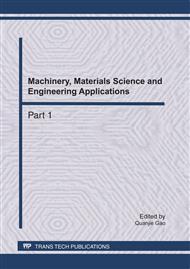[1]
Qianzhe Zhao, Yibing Liu, Yanpin Liu and Weisong Zhou: Application on Induction Heating to Steel Wire Products, Industrial Heating, Vol. 38 (2009), pp.12-14.
DOI: 10.1049/cp.2010.1268
Google Scholar
[2]
Jingming Tang: Design of Induction Heating Equipment, Industrial Heating, Issue 2(1995), pp.35-39.
Google Scholar
[3]
Qianzhe Zhao, Yibing Liu, Yanpin Liu and Weisong Zhou: Numerical simulations for the Induction Heating Process of Non-linear Ferromagnetic Billets, IET International Conference on Advanced Technology of Design and Manufacture (2010), in press.
DOI: 10.1049/cp.2010.1268
Google Scholar
[4]
Y. Favennec, V. Labbe, Y. Tillier and F. Bay: Identification of magnetic parameters by inverse analysis coupled with finite-element modeling, IEEE Transactions on Magnetics, Vol. 38(2002), pp.3607-3619.
DOI: 10.1109/tmag.2002.804815
Google Scholar
[5]
V. Rudnev: Handbook of Induction Heating, Madison Heights, Michigan, U.S. A, (2003), p.129.
Google Scholar
[6]
A. Canova, F. Dughiero, F. Fasolo, M. Forzan, F. Freschi, Giaccone. L and Repetto. M: Identification of Equivalent Material Properties for 3-D Numerical Modeling of Induction Heating of Ferromagnetic Workpieces, IEEE Transactions on Magnetics, Vol. 45(2009).
DOI: 10.1109/tmag.2009.2012830
Google Scholar
[7]
K. F. Wang, S. Chadrasekar and H. T. Y. Yang: Finite element simulation of induction heat treatment, J. Mater. Eng. Perf., Vol. 1(1992), pp.97-112.
Google Scholar
[8]
Jianhua Jiang and Huayi Zheng: Numerical Simulation of Continuous Induction Heat Treatment of Thick Wall Tubes by Finite Element Method, Transactions of Materials and Heat Treatment, Vol. 23(2002), pp.43-48.
Google Scholar
[9]
R. Goldstein, V. Nemkov and R. Madeira: Optimizing axle-scan hardening inductors, ASM International Conference, Detroit(2007).
Google Scholar
[10]
P. Ross, V. Rudnev, R. Gallik and G. Elliott: Innovative Induction Heating of Oil Country Tubular Goods, Industrial Heating, Vol. 75(2008), pp.67-73.
Google Scholar
[11]
F. Bay, V. Labbe, Y. Favennec and J. L. Chenot: A numerical model for induction heating processes coupling electromagnetism and thermomechanics, International journal for numerical methods in engineering, Vol. 58(2008), pp.839-867.
DOI: 10.1002/nme.796
Google Scholar
[12]
Masato Enokizono, Takashi Todaka and Shotaro Nishimura: Finite Element Analysis of High-Frequency Induction Heating Problems Considering Inhomogeneous Flow of Exciting Currents, IEEE Transactions on Magnetics, Vol. 33(1999), pp.1646-1649.
DOI: 10.1109/20.767321
Google Scholar


